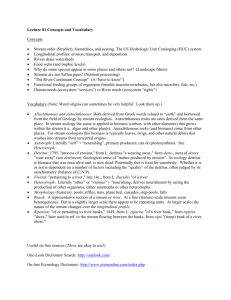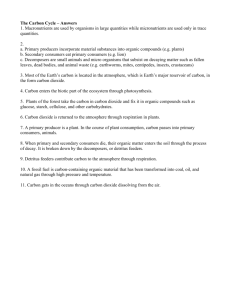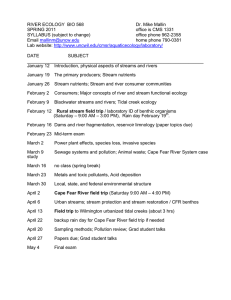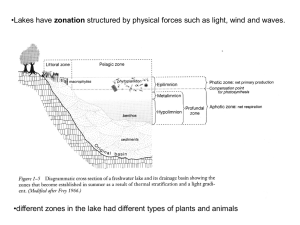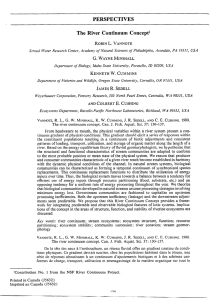STREAM ECOLOGY ENERGY—SOURCES Energy is stored and used through two fundamental processes:
advertisement
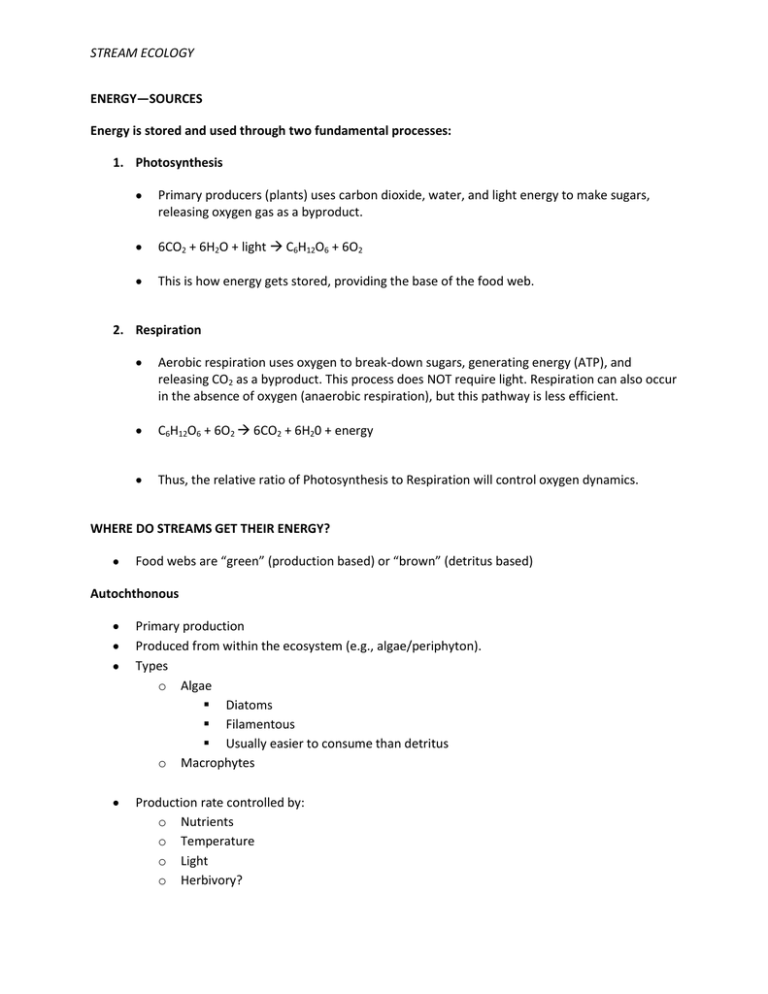
STREAM ECOLOGY ENERGY—SOURCES Energy is stored and used through two fundamental processes: 1. Photosynthesis Primary producers (plants) uses carbon dioxide, water, and light energy to make sugars, releasing oxygen gas as a byproduct. 6CO2 + 6H2O + light C6H12O6 + 6O2 This is how energy gets stored, providing the base of the food web. 2. Respiration Aerobic respiration uses oxygen to break-down sugars, generating energy (ATP), and releasing CO2 as a byproduct. This process does NOT require light. Respiration can also occur in the absence of oxygen (anaerobic respiration), but this pathway is less efficient. C6H12O6 + 6O2 6CO2 + 6H20 + energy Thus, the relative ratio of Photosynthesis to Respiration will control oxygen dynamics. WHERE DO STREAMS GET THEIR ENERGY? Food webs are “green” (production based) or “brown” (detritus based) Autochthonous Primary production Produced from within the ecosystem (e.g., algae/periphyton). Types o Algae Diatoms Filamentous Usually easier to consume than detritus o Macrophytes Production rate controlled by: o Nutrients o Temperature o Light o Herbivory? STREAM ECOLOGY Allochthonous Organic matter that falls into the stream. This can be fallen leaves, sticks, carcasses, etc. Also known as detritus. Often falls in as CPOM—coarse particulate organic matter Produced outside of ecosystem (e.g., leaf litter fall) Terrestrial vegetation is usually more difficult to digest than aquatic algae Organic inputs controlled by: o Riparian vegetation type o Season o Ratio of edge:area Evidence for the importance of detritus a. Detritus is rapidly broken down i. Leach out dissolved organic carbon. ii. Colonized by microbes iii. Invertebrates eat leaves (and microbes). b. Chemical signatures of detritus often support stream food webs. c. Removing detritus decreases production of stream bugs. i. Large-scale experiment by Wallace et al. 1997 River Continuum Concept In 1980 a bunch of stream ecologists, led by Robin Vannote, wrote a paper that described the River Continuum Concept. This became perhaps the first unified hypothesis about how streams from headwaters on down. The River Continuum is a predictive framework that describes how streams systematically change as one goes from small headwater streams to large lowland rivers. STREAM ECOLOGY Predictions from River Continuum Concept: As go downstream, streams fundamentally shift: Carbon source: Shifts from allochthony (detritus) to autothony (algae). Particle size: Shifts from CPOM to FPOM. Photosynthesis: Respiration ratio Benthic invertebrates communities follow these changes. Stream systems often (but not always) match these predictions Figure to the right shows some data from Naiman et al. 1987 on stream carbon budgets as a function of increasing stream order (xaxis)
